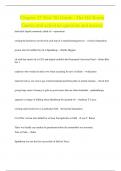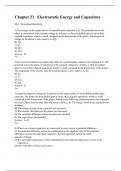Popular courses 'CHAPTER 23' at CHAPTER 23
CHAPTER 23 Study guides, Class notes & Summaries
Looking for the best study guides, study notes and summaries about CHAPTER 23? On this page you'll find 15 study documents about CHAPTER 23.
All 15 results
Sort by
Chapter 23 Test 7th Grade - The Oil Boom Games and activities question and answer
Chapter 23 Electrostatic Energy and Capacitors
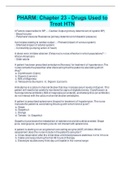
-
PHARM: Chapter 23 - Drugs Used to Treat HTN
- Exam (elaborations) • 14 pages • 2023
-
- $13.49
- + learn more
3 Factors responsible for BP - - Cardiac Output (primary determinant of systolic BP) - Blood Volume - Peripheral Vascular Resistance (primary determinant of diastolic pressure) 3 principles relating to cardiac output - - Preload (impact of venous system) - Afterload (impact of arterial system) - Contractility (pumping action of heart) A direct renin inhibitor aliskiren (Tekturna) is not as effective in which populations? - - African Americans - Older adults A patient has been prescribed...
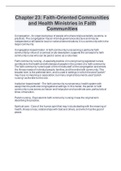
-
Faith-Oriented Communities and Health Ministries in Faith Communities
- Exam (elaborations) • 1 pages • 2023
- Available in package deal
-
- $9.99
- + learn more
Congregation - An organized group of people who share religious beliefs, customs, or practices. The congregation has an internal governance structure and may be independent or affiliated to local or national denominations. It is a community within the larger community. Congregation-based model - A faith community nurse serving a particular faith community by virtue of a contract or job description; supports the concept of a faith community nurse who can be paid or serve as a volunteer...
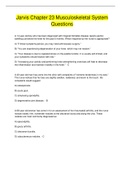
-
Jarvis Chapter 23 Musculoskeletal System Questions
- Exam (elaborations) • 14 pages • 2022
-
- $13.49
- + learn more
A 14-year-old boy who has been diagnosed with Osgood-Schlatter disease reports painful swelling just below the knee for the past 5 months. Which response by the nurse is appropriate? A) "If these symptoms persist, you may need arthroscopic surgery." B) "You are experiencing degeneration of your knee, which may not resolve." C) "Your disease is due to repeated stress on the patellar tendon. It is usually self-limited, and your symptoms should resolve with rest." D) "Increasing your...
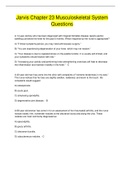
-
Jarvis Chapter 23 Musculoskeletal System Questions
- Exam (elaborations) • 14 pages • 2022
-
- $13.49
- + learn more
A 14-year-old boy who has been diagnosed with Osgood-Schlatter disease reports painful swelling just below the knee for the past 5 months. Which response by the nurse is appropriate? A) "If these symptoms persist, you may need arthroscopic surgery." B) "You are experiencing degeneration of your knee, which may not resolve." C) "Your disease is due to repeated stress on the patellar tendon. It is usually self-limited, and your symptoms should resolve with rest." D) "Increasing your...
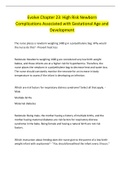
-
ELNEC End-of-Life Nursing Education Consortium. Module 5: Loss, Grief and Bereavement. Section 2: Overview of Loss, Grief, and Bereavement,,ECPI 2020: CHAPTER 4: ALTERED IMMUNITY,,,,
- Package deal • 5 items • 2022
-
- $15.49
- + learn more
ELNEC End-of-Life Nursing Education Consortium. Module 5: Loss, Grief and Bereavement. Section 2: Overview of Loss, Grief, and Bereavement,,ECPI 2020: CHAPTER 4: ALTERED IMMUNITY,,,,

-
Evolve Chapter 23: High Risk Newborn Complications Associated with Gestational Age and Development
- Exam (elaborations) • 7 pages • 2022
- Available in package deal
-
- $10.49
- + learn more
The nurse places a newborn weighing 1400 g in a polyethylene bag. Why would the nurse do this? - Prevent heat loss Rationale: Newborns weighing 1400 g are considered very low birth weight babies, and these infants are at a higher risk for hypothermia. Therefore, the nurse places the newborn in a polyethylene bag to decrease heat and water loss. The nurse should constantly monitor the neonate for an increase in body temperature to assess if the infant is developing an infection. Whic...
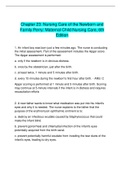
-
Chapter 23: Nursing Care of the Newborn and Family Perry: Maternal Child Nursing Care, 6th Edition
- Exam (elaborations) • 13 pages • 2022
-
- $12.49
- + learn more
1. An infant boy was born just a few minutes ago. The nurse is conducting the initial assessment. Part of the assessment includes the Apgar score. The Apgar assessment is performed: a. only if the newborn is in obvious distress. b. once by the obstetrician, just after the birth. c. at least twice, 1 minute and 5 minutes after birth. d. every 15 minutes during the newborn's first hour after birth. - ANS: C Apgar scoring is performed at 1 minute and 5 minutes after birth. Scoring may c...
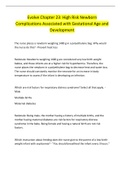
-
Evolve Chapter 23: High Risk Newborn Complications Associated with Gestational Age and Development
- Exam (elaborations) • 7 pages • 2022
-
- $10.49
- + learn more
The nurse places a newborn weighing 1400 g in a polyethylene bag. Why would the nurse do this? - Prevent heat loss Rationale: Newborns weighing 1400 g are considered very low birth weight babies, and these infants are at a higher risk for hypothermia. Therefore, the nurse places the newborn in a polyethylene bag to decrease heat and water loss. The nurse should constantly monitor the neonate for an increase in body temperature to assess if the infant is developing an infection. Whic...

Study stress? For sellers on Stuvia, these are actually golden times. KA-CHING! Earn from your study resources too and start uploading now. Discover all about earning on Stuvia

